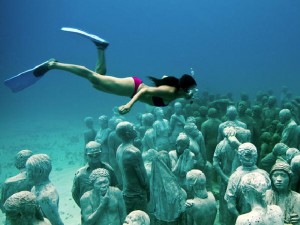
Tennile 2004 , chromogenic color print , acquired through the generosity of Dr. Michael L. Jacobs, 2006
Ambiguous, and filled with suggestion Mr. diCorcia’s photo Tennille suggest a more explicit narrative , Tennile 2004 , chromogenic color print , acquired through the generosity of Dr. Michael L. Jacobs, 2006 . The photo depicts a stripper “ working the pole” is what I like to call it . The photograph captures the dancer in mid routine with her legs wrapped around the stripper pole while her body gracefully dangled. The dancer is bath with a bright light which showed how gracefully she danced on the stripper pole. The lighting of this photo gave such a dramatic image which showed the dancer in a powerful way, it showed her as a strong powerful woman who owns the stage and is in charge. This photo tells a narrative about the dancer, it made me create a short story in my head. The photo made me gave the dancer a back story as to who she is and why she’s a stripper. Which is exactly what the artist is trying to capture. He plays on the moral values of society. The artist usually paid his subjects the same price they charge for their services. However, there is no price in the description of this particular photo so it made me wondered how much he paid the stripper for this photo.
“Hustlers,” his best-known series, according to most art critics is the most well-represented, with 14 large and small shots of mostly young men strutting their stuff along Santa Monica Boulevard in Hollywood. Made from 1990 to 1992 and funded with a National Endowment for the Arts fellowship, DiCorcia’s breakout series features men posing for their portraits in motel rooms , parking lots and laundromats, outside fast-food restaurants, gas stations and boarded-up buildings, and simply sitting at bus stops or on street corners, usually at dusk.
The different Parts of this series can be found by clicking on the links : Part 1 , Part 2 , Part 3 , Part 4















 @oba1911 for @rumorsofwarnyc #streetwear #fashion #streetstyle #streetfashion #hypebeast #mensfashion #fashionblogger #nike #streetwearfashion #clothingbrand #sneakerhead #supreme #outfitoftheday #instagood #menswear #instafashion #photography #jordan #explorerpage #sneakerhead #model #adidas #yeezy #hypebeast #photooftheday #menstyle #urbanwear #offwhite #hiphop #bape https://www.instagram.com/p/CfHh2e8Omu-/?igshid=NGJjMDIxMWI=
@oba1911 for @rumorsofwarnyc #streetwear #fashion #streetstyle #streetfashion #hypebeast #mensfashion #fashionblogger #nike #streetwearfashion #clothingbrand #sneakerhead #supreme #outfitoftheday #instagood #menswear #instafashion #photography #jordan #explorerpage #sneakerhead #model #adidas #yeezy #hypebeast #photooftheday #menstyle #urbanwear #offwhite #hiphop #bape https://www.instagram.com/p/CfHh2e8Omu-/?igshid=NGJjMDIxMWI=

